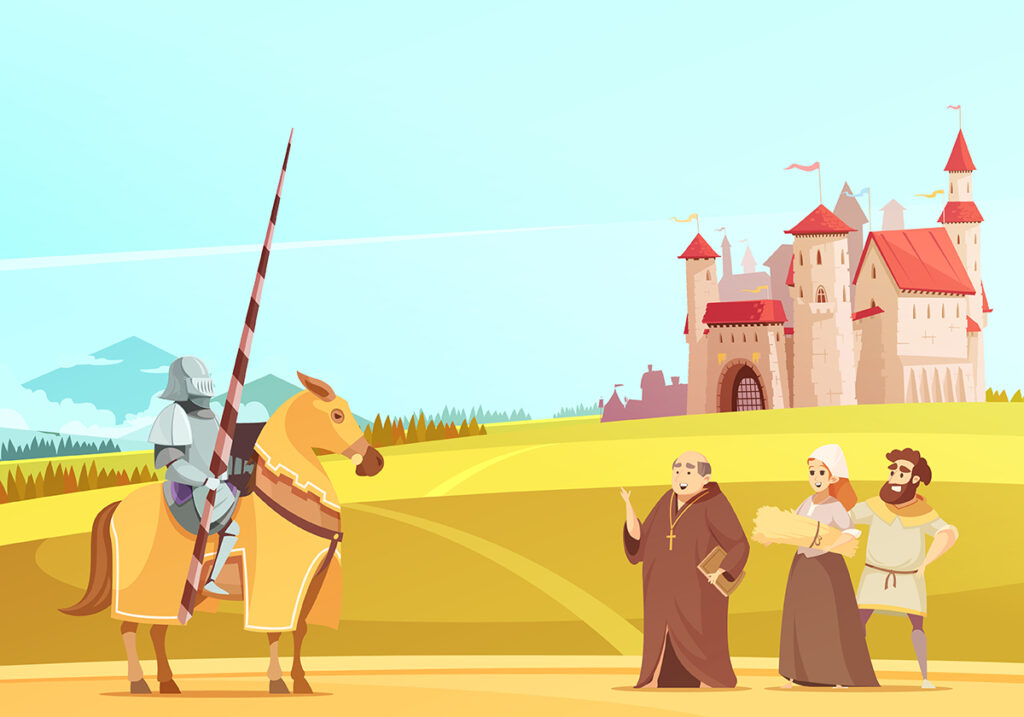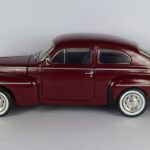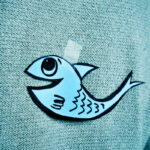- Cities: In the 12th century, the population of the largest cities was still very sparse. London and Paris, for example, had 30-40,000 inhabitants, while Venice and Florence were home to around 100,000 people each. The largest city at this time was Constantinople (now Istanbul) with around 1 million inhabitants
- Clothes: Men – especially the nobility – wore very tight clothing. Tight-fitting gaiters and tight corsets were common clothing for men. From the 1330s onwards, ‘long-toed shoes’ came into fashion. The shoes could be up to 60 cm long and were reinforced with wool, moss or whalebone to keep their shape
- Small pets: Medieval livestock were generally small and often in poor health. A full-grown bull was typically only slightly larger than a modern calf and sheep were only about 1/3 of their size today (all of this is largely due to human breeding of the animals as well as technological and scientific “advances”)
- Medieval football: In European cities – especially the English ones – several varieties of soccer developed. The common denominators were an unlimited number of participants, an inflated pig bladder as a ball and an awful lot of hooting and hollering. For the latter reason, football was banned by law by King Edward II in 1314
- Witches: Witches and witchcraft were illegal and frowned upon throughout the Middle Ages. Laws and punishments varied in different areas of Europe. One example is the early 7th century Alamanni code of law, Pactus Alamannorum, which states that “witchcraft is a crime punishable on a par with poisoning”. With the spread of Christianity, witchcraft knowledge began to be considered superstition, which could be punishable (i.e. the accuser risked punishment for believing that witches existed). From the early 9th century, the death penalty for witchcraft was introduced, and it became more common for the people to punish the witch – which was considerably more cruel
- Condemned animals: Domestic animals as well as wild animals could be convicted in court for injuring or killing humans and in some cases also minor violations of the law. In one case, a mouse was convicted of stealing part of the harvest. In another case, a swarm of locusts was convicted of eating crops – and they weren’t even present in court…
- Mandatory archery: In England, King Edward III made archery compulsory for all men. They had to train for two hours every Sunday under the supervision of the local clergy (clergy)
- Woman in battle: The Countess of Leicester, Petronilla de Grandmesnil, fought alongside her husband Robert in a rebellion against King Henry II. However, things didn’t go quite as planned; she fled the battle and was found in a nearby ditch where she tried to drown herself…
- Brother: There weren’t many bridges in the early Middle Ages. Most rivers had boats that crossed for a fee. On smaller rivers and streams, there was usually just a road that ended in the water and continued on the other side. If you were lucky, there were some large stones laid out to avoid getting your feet wet. When there was a bridge, it was not uncommon to have to pay – or fight – to cross it. Later in the Middle Ages, however, many bridges began to be built across Europe and in many places were even inhabited. In this context, bridges also became central to the conquest of cities
- The future: A French monk named Roger Bacon who lived from 1214 to 1292 predicted some of the inventions of the future. In his work ‘Epistola de Secretis Operibus’, he wrote: ‘Vehicles can be made to move with incredible speed without draft animals’ and ‘flying machines can be constructed with artificial wings that can flap in the air like a bird’. He also foresaw steamships, submarines and diving suits
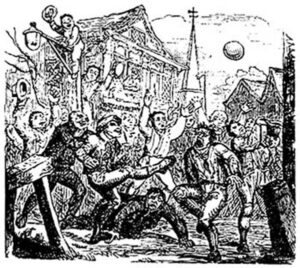
Medieval football was especially popular in England, but was eventually banned by law because it was too violent and noisy
Food in the Middle Ages
- The hierarchy of food: Food in the Middle Ages followed the following hierarchy:
- Birds were the foremost food, because of all animals they were closest to God and heaven
- Fish and seafood was second best because the apostle Peter had originally been a fisherman
- Land animals such as oxen, pigs and deer, were in the middle of the hierarchy because they lived on land and were thus midway between Heaven and Hell
- Grains, fruits and vegetables grew above the surface of the earth and was therefore the second lowest in the hierarchy
- Root crops were the lowest in the hierarchy because they grew in the ground and were closest to Hell. Root vegetables were only eaten by the lower classes
- King’s menu: At medieval royal feasts, no expense was spared on food. An example would be King Richard II’s banquet, where the “shopping list” included the following: 16 oxen, 120 sheep, 12 wild boars, 14 calves, 140 pigs, 3 tons of salted venison, 50 swans, 110 geese, 720 chickens, 400 hares, 400 herons, 5 egrets, 1200 pigeons, 144 partridges, 72 rabbits, 12 cranes, “enough game birds”, 50 liters of cream and 11,000 eggs
- Tailor’s window shade: Guillaume Tirel (1310 – 1395), a Frenchman, worked his way in 60 years (1320s to 1380s) from a lowly kitchen boy to the king’s master chef. His cooking earned him a knighthood at a time when cooks were generally considered mere servants – and even devils (because the kitchen was an unbearably hot, smoky place that was the closest thing to hell). He was later given the name Taillevent, which means “wind cutter” after his skill with a kitchen knife. In the years 1373 – 1380, he collected recipes and published his cookbook ‘Le Viandier’, which included recipes such as ‘sheep’s stomach stuffed hedgehog baked in clay’ or ‘pies with live birds‘. Taillevent is today considered the progenitor of French cuisine and restaurants in French-speaking countries are often named after him
- Alcohol: In the Middle Ages, alcohol was the most common beverage and everyone – children, adults, rich and poor – drank thin beer throughout the day. This was mainly due to the fact that water was usually contaminated and milk and alcohol were the only alternatives. Later in the Middle Ages, the upper classes started drinking wine instead of beer
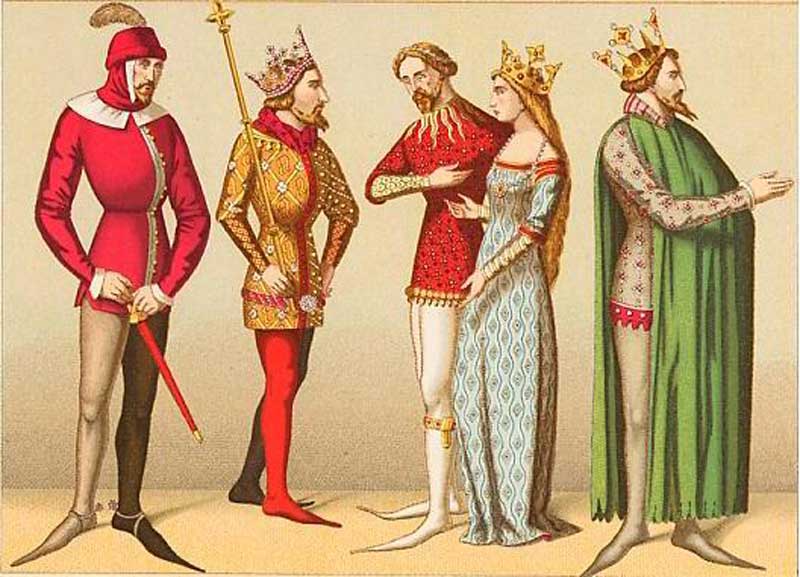
Fact: The upper class in the Middle Ages typically wore tight gaiters and long-toed shoes
The periods of the European Middle Ages
The Middle Ages is a historical period that lasted from the 5th century to the 15th century in Europe. It started with the collapse of the Western Roman Empire and ended with the Renaissance.
The Middle Ages are also the middle period in three traditional divisions of Western history: Antiquity, the Middle Ages and the Modern Age. However, the duration of the Middle Ages varied in individual European countries, which is why the Middle Ages cannot be dated with more precise dates or years for all of Europe
The Middle Ages are commonly divided into three periods: Early Middle Ages, High Middle Ages and Late Middle Ages.
Early Middle Ages
This part of the Middle Ages lasted from the 5th century to the 10th century and followed the fall of the Western Roman Empire. The early Middle Ages were largely influenced by trends from late antiquity such as population decline (especially in city centers), a decline in trade and an increase in immigration. The term ‘Dark Ages’ is also used to describe the early Middle Ages, referring in particular to the lack of or poor literary and cultural progress in Western Europe at the time.
The Eastern Roman Empire (or Byzantine Empire), on the other hand, continued to thrive and in the 7th century, the Islamic Caliphates began to conquer parts of the Roman territories. In the Iberian Peninsula in the south of Spain, culture, art and learning flourished and Córdoba was the largest city in the world during this period. Therefore, the term ‘Dark Ages’ is an inappropriate description of the Iberian Peninsula at this time.
High Middle Ages
The European High Middle Ages lasted from the 11th century to the 13th century and was particularly characterized by high population growth, which brought with it major social and political changes. Around 1250, the steady population growth caused the European economy to reach growth levels that wouldn’t be seen again until the 19th century.
At the end of the High Middle Ages (early 14th century), Europe was hit by a series of crises that halted population and economic growth. The crises are commonly divided into three groups:
- Demographic collapse: Europe’s overpopulation, combined with icy winters and high precipitation, caused poor agricultural conditions, leading to famine, which eventually developed into malnutrition and more diseases in the population
- Political instability: Rebellions were not uncommon before the 14th century, but until then they had generally been small and very localized. In the 14th and 15th centuries, this all changed as rulers increased pressure on the poor, causing the lower classes to rebel more. In Germany, for example, there were no less than 60 peasant revolts between the years 1336 and 1525 (more than 3 revolts per year!)
- Religious upheaval: The Roman Catholic Church was split by the Great Schism. The Holy Roman Empire (also called the ‘Holy Roman Empire of the German Nation’) was also in decline
In addition, there was also the plague – the ‘Black Death’ – from 1346 to 1353, which killed between 75 and 200 million people in Eurasia. It is estimated that 30 – 60% of Europe’s population was wiped out and worldwide, it is estimated that the population dropped from 450 million to 350 – 375 due to the plague (the numbers can be hard to reconcile, obviously).
Despite the crises and the plague, there was – overall – some progress in the arts and sciences in the 14th century.
Late Middle Ages
The last part of the Middle Ages – the Late Middle Ages – is the period before the early modern era and in much of Europe; the Renaissance.
The Italian Renaissance began with a renewed interest in Greek and Roman texts. Many scholars from the Byzantine Empire also came to Italy to seek refuge from the Ottomans, who had just conquered the Byzantine capital of Constantinople. The presence of scholars accelerated the Italian Renaissance.
It was also in the late Middle Ages that the first European printing press was invented, which naturally facilitated the spread of the written word and generally made learning more accessible.
In the late Middle Ages, the ‘Age of Discovery’ began as a result of the Ottoman Empire’s conquest of Constantinople and general expansion; Europeans were now cut off from trade with Asia and had to find new trade routes. This led to Columbus’ discovery of America in 1492 and Vasco da Gama’s circumnavigation of India and Africa in 1498. These discoveries significantly strengthened the economy and power of European nations.
It is these changes that, for most historians, mark the end of the Middle Ages and the beginning of the modern era. However, some historians believe that the late Middle Ages is a misnomer and that the period was simply a continuation of the High Middle Ages, which gradually evolved into the modern era.
The end of the Middle Ages
Culturally, the Renaissance marks the end of the Middle Ages. The cultural elite began to worship antiquity and wished to return to it – viewing the period from antiquity to the Renaissance as an undesirable ‘Dark Ages’.
Economically and power-wise, the Age of Discovery marks the end of the Middle Ages. As educated travelers begin to explore the world and the power of European countries grows, a new era begins.

